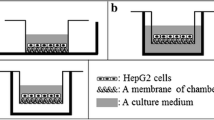Abstract
The bioartificial liver (BAL) device is an extracorporeal liver support system incorporating living hepatocytes. A major problem in BAL device development is to obtain a high number of functional cells. In this study, we focused on a genetically engineered mouse hepatoma cell line, Hepa/8F5, in which elevated liver functions are induced via overexpression of liver-enriched transcription factors activated by doxycycline (Dox) addition. We applied a three-dimensional culture technique using hollow fibers (HFs) to Hepa/8F5 cells. Hepa/8F5 cells responded to Dox addition by reducing their proliferative activity and performing liver-specific functions of ammonia removal and albumin secretion. The functional activities of cells depended on the timing of Dox addition. We also found that Hepa/8F5 cells in the HF culture were highly functional in a low rather than high cell density environment. We further fabricated an HF-type bioreactor with immobilized Hepa/8F5 cells as a BAL device. Although ammonia removal activity of this BAL device was lower than that of the small-scale HF bundle, albumin secretion activity was slightly higher. These results indicated that the BAL device with immobilized Hepa/8F5 cells was highly functional with potential to show curative effects in liver failure treatment.







Similar content being viewed by others
References
Amimoto N, Mizumoto H, Nakazawa K et al (2011) An evaluation of the utility of the hepatic differentiation method using hollow fiber/organoid culture for the development of a hybrid artificial liver device. Biochem Eng J 56:69–74. https://doi.org/10.1016/j.bej.2011.05.010
Aoki K, Mizumoto H, Nakazawa K et al (2008) Evaluation of a hybrid artificial liver module with liver lobule-like structure in rats with liver failure. Int J Artif Organs 31:55–61. https://doi.org/10.1177/039139880803100108
Demetriou AA, Brown RS, Busuttil RW et al (2004) Prospective, randomized, multicenter, controlled trial of a bioartificial liver in treating acute liver failure. Ann Surg 239:660–670. https://doi.org/10.1097/01.sla.0000124298.74199.e5
Evans MJ, Kaufman MH (1981) Establishment in culture of pluripotential cells from mouse embryos. Nature 292:154–156. https://doi.org/10.1038/292154a0
Kashiwagura T, Deutsch CJ, Taylor J et al (1984) Dependence of gluconeogenesis, urea synthesis, and energy metabolism of hepatocytes on intracellular pH. J Biol Chem 259:237–243
Martin GR (1981) Isolation of a pluripotent cell line from early mouse embryos cultured in medium conditioned by teratocarcinoma stem cells. Proc Natl Acad Sci 78:7634–7638. https://doi.org/10.1073/pnas.78.12.7634
Millis JM, Cronin DC, Johnson R et al (2002) Initial experience with the modified extracorporeal liver-assist device for patients with fulminant hepatic failure: system modifications and clinical impact. Transplantation 74:1735–1746. https://doi.org/10.1097/01.TP.0000038483.93833.21
Mizumoto H, Ishihara K, Nakazawa K et al (2008) A new culture technique for hepatocyte organoid formation and long-term maintenance of liver-specific functions. Tissue Eng Part C Methods 14:167–175. https://doi.org/10.1089/ten.tec.2007.0373
Mizumoto H, Hayashi S, Matsumoto K et al (2012) Evaluation of a hybrid artificial liver module based on a spheroid culture system of embryonic stem cell-derived hepatic cells. Cell Transplant 21:421–428. https://doi.org/10.3727/096368911X605321
Mizumoto H, Amimoto N, Miyazawa T et al (2018) In vitro and ex vivo functional evaluation of a hollow fiber-type bioartificial liver module containing ES cell-derived hepatocyte-like cells. Adv Biomed Eng 7:18–27. https://doi.org/10.14326/abe.7.18
Mundt A, Puhl G, Müller A et al (2002) A Method to assess biochemical activity of liver cells during clinical application of extracorporeal hybrid liver support. Int J Artif Organs 25:542–548. https://doi.org/10.1177/039139880202500609
Nyberg SL, Misra SP (1998) Hepatocyte liver-assist systems—a clinical update. Mayo Clin Proc 73:765–771. https://doi.org/10.4065/73.8.765
Okudaira T, Yabuta R, Mizumoto H, Kajiwara T (2017) Fabrication of a fiber-type hepatic tissue by bottom-up method using multilayer spheroids. J Biosci Bioeng 123:739–747. https://doi.org/10.1016/j.jbiosc.2017.01.002
Sakiyama R, Blau BJ, Miki T (2017) Clinical translation of bioartificial liver support systems with human pluripotent stem cell-derived hepatic cells. World J Gastroenterol 23:1974–1979. https://doi.org/10.3748/wjg.v23.i11.1974
Sauer IM, Zeilinger K, Obermayer N et al (2002) Primary human liver cells as source for modular extracorporeal liver support—a preliminary report. Int J Artif Organs 25:1001–1005. https://doi.org/10.1177/039139880202501015
Takahashi K, Yamanaka S (2006) Induction of pluripotent stem cells from mouse embryonic and adult fibroblast cultures by defined factors. Cell 126:663–676. https://doi.org/10.1016/j.cell.2006.07.024
Takahashi K, Tanabe K, Ohnuki M et al (2007) Induction of pluripotent stem cells from adult human fibroblasts by defined factors. Cell 131:861–872. https://doi.org/10.1016/j.cell.2007.11.019
Ulrich C, Krüger B, Köhler H, Riegel W (1999) Effects of acidosis on acute phase protein metabolism in liver cells. Miner Electrolyte Metab 25:228–233. https://doi.org/10.1159/000057453
van de Kerkhove MP, Hoekstra R, Chamuleau RAFM, van Gulik TM (2004) Clinical application of bioartificial liver support systems. Ann Surg 240:216–230. https://doi.org/10.1097/01.sla.0000132986.75257.19
Wang L, Sun J, Li L et al (1998) Comparison of porcine hepatocytes with human hepatoma (C3A) cells for use in a bioartificial liver support system. Cell Transplant 7:459–468. https://doi.org/10.1177/096368979800700505
Wilson CA (2008) Endogenous retroviruses: porcine endogenous retroviruses and xenotransplantation. Cell Mol Life Sci 65:3399–3412. https://doi.org/10.1007/s00018-008-8498-z
Yamamoto H, Kawabe Y, Ito A, Kamihira M (2012) Enhanced liver functions in mouse hepatoma cells by induced overexpression of liver-enriched transcription factors. Biochem Eng J 60:67–73. https://doi.org/10.1016/j.bej.2011.10.004
Yamamoto H, Tonello JM, Sambuichi T, Kawabe Y, Ito A, Kamihira M (2018) Characterization of genetically engineered mouse hepatoma cells with inducible liver functions by overexpression of liver-enriched transcription factors. J Biosci Bioeng 125:131–139. https://doi.org/10.1016/j.jbiosc.2017.07.011
Acknowledgements
We would like to thank Takahiro Ono (UNITIKA LTD.) for providing hollow fibers.
Funding
This study was supported in part by a Grant-in-Aid for Scientific Research (C) (17K06928) from the Japan Society for the Promotion of Science.
Author information
Authors and Affiliations
Corresponding author
Ethics declarations
Conflict of interest
The authors declare that they have no conflict of interest.
Additional information
Publisher's Note
Springer Nature remains neutral with regard to jurisdictional claims in published maps and institutional affiliations.
Rights and permissions
About this article
Cite this article
Fujii, Y., Higashi, K., Mizumoto, H. et al. A bioartificial liver device based on three-dimensional culture of genetically engineered hepatoma cells using hollow fibers. Cytotechnology 72, 227–237 (2020). https://doi.org/10.1007/s10616-020-00372-0
Received:
Accepted:
Published:
Issue Date:
DOI: https://doi.org/10.1007/s10616-020-00372-0



